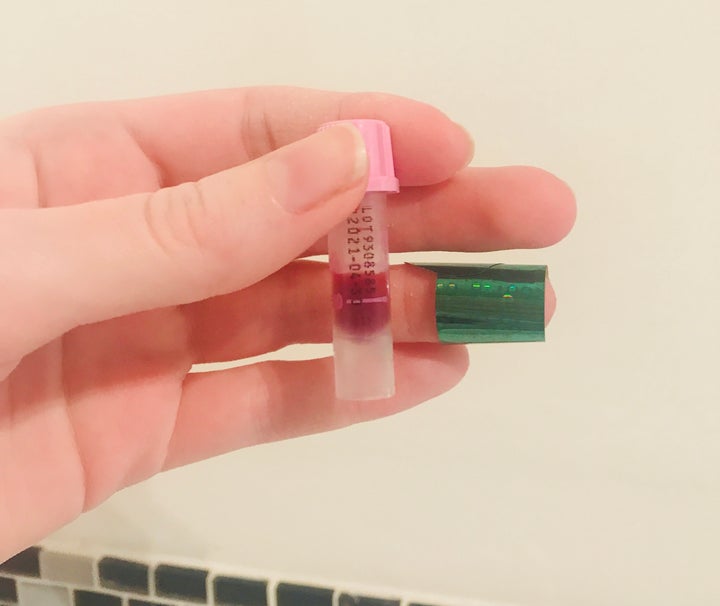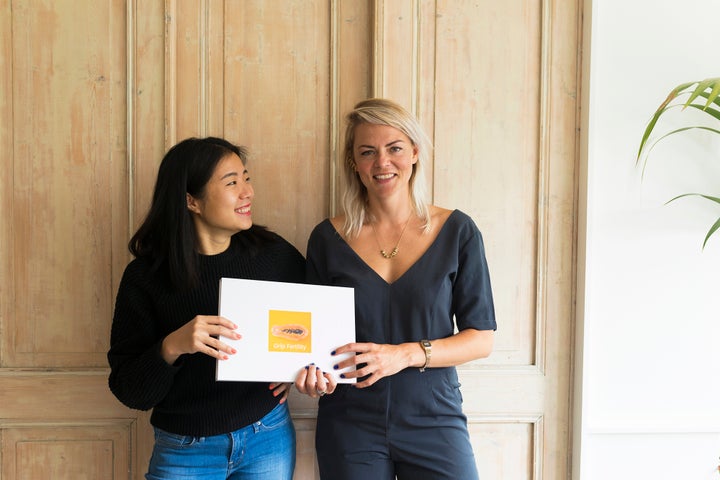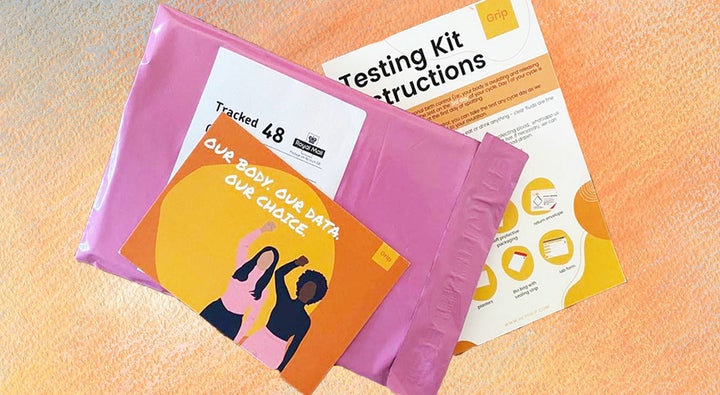Drip, drip. Drip, drip. Small droplets of blood fall from my finger into the tiny test tube. Pricking myself with the needle was less painful than I’d expected, but gathering the sample is a slow process. The pamphlet tells me it can take 10 to 30 minutes, depending on blood flow, and some women need to prick twice.
As I stand alone in my bathroom, afraid to look away in case I spill a drop, the thing that’s keeping me going is the idea this might help answer a big question: when should I have a baby?
The hormone test is part of Grip, a new at-home ‘fertility MOT’ launching in the UK on March 1, and it’s designed to rule out the four main risk factors that make it harder for women to get pregnant: ovulation issues (often linked to polycystic ovary syndrome or PCOS), blocked fallopian tubes, thyroid issues, and low ovarian reserve – ie. the remaining number of eggs in your ovaries.
The test won’t tell you if you will or won’t get pregnant, but it might influence some life choices. “Think of your Grip test as a risk profile, rather than a yes or no answer,” the website tells me. “If you know your risks when you’re still young, then you still have all the options to do something about them.”
If you’re not on hormonal birth control, you can send your blood to the Grip lab and be tested for all four conditions for £139. If you’re on the pill, have an IUD or an implant, this skews the first three results, but you can still have your AMH levels checked for £99.
AMH is a key indicator of ovarian reserve and for me, it’s the big one: do I have a decent amount of eggs for my age? Should I hurry up with this motherhood malarkey, or can I get away with a delay?
I massage my finger to squeeze out another few drops, in a technique the bright orange packaging names “milking”. My face looks pale grey in the bathroom mirror. I secure the test tube lid pronto, then sway to the kitchen for a Jammie Dodger.

“How do you feel?!” Grip’s energetic co-founder Anne Marie Droste asks me over the phone later that day. The test had to be carried out first thing in the morning on an empty stomach, then wrapped in protective packaging before being popped in the postbox. It’ll take at least five days until my results are in.
“I am a little nervous,” I reply. “It’s one of those things, isn’t it – do I want to know, or is ignorance bliss?”
Droste reassures me that’s exactly how she felt before her first hormone test. Two years ago, at the age of 30, she quit her job and was about to embark on an extended round-the-world trip with her boyfriend. Family raised the topic of babies – and whether she planned to “pop home” to pop one out – and for the first time, she felt confronted by her fertility.
Unsure if she even wanted kids, Droste who’s originally from the Netherlands, visited her GP. She was told about fertility hormone testing, but advised these tests are usually only given to women who’ve been trying to conceive for a year. The situation is similar here in the UK, where tests are at the discretion of local NHS clinical commissioning groups (and the enthusiasm of your GP).
NICE guidelines say women who’ve “not conceived after one year of unprotected vaginal sexual intercourse... should be offered further clinical assessment and investigation.” The guidelines do not cater for single women who may also want answers, or women in same-sex relationships who’d like to plan future IVF.
For these women, the only guaranteed free option is to turn to Google, says Droste, where you’ll find age-based averages on fertility – and not much else.
“I think it’s really harmful for women to have to decide things based on national averages,” she says. “There’s nothing that has a bigger impact on our lives and careers and happiness than whether or not we decide to have kids, so it seems really archaic to me that we have to make those decisions in the dark, on our own, without any information.”

Wanting answers, Droste paid £600 for tests at a private clinic, which revealed she had a slightly low egg reserve for her age and was considered above average risk for early menopause. She’s since decided to freeze her eggs.
“I’m still really not sure if I want kids, but it highlighted that I definitely wanted to have the option of kids,” she says. “Even though it wasn’t the answer I wanted per se, I now know what I’m in for. I understand the risks I’m taking by waiting, rather than being in the dark and pretending everything is probably going to be fine.”
When Droste shared her experience with two trusted friends, Noor Teulings (a fertility doctor) and Ling Lin (a product manager, who was single at the time and considering egg freezing), they conceived a bigger idea. “It sounds really lame, but we had lunch that day and decided maybe we should be building a company that allows people like us to have this information,” Droste explains.
The trio co-founded Grip in March 2020 and launched in the Netherlands in May, where they’ve already sold 3,000 kits. They expected their core market to be women in their 30s, already trying to conceive but frustrated by the one-year waiting time. Instead, their average user is 28 and curious about her future. She wants to be proactive about her fertility, rather than wait until something is wrong. At 29, I’m a textbook client.
“She [the average customer] doesn’t want to have kids for the next few years and is really aware that the last time she learned anything about her hormonal cycle or her body is when she was 16 and in sex ed,” says Droste
“It feels like we’re living in this era of hormonal awareness, in which we’re demanding better answers about what’s happening in our bodies. And what’s happening in my body, what’s happening to me personally. We don’t want the average woman’s story.”
The packaging has certainly been designed with millennials in mind: bright colours and feminist slogans are accompanied with fun instructions – “Do the Macarena to get your blood flowing to your fingertips!”
The message is clear: this is an empowering test, made for empowered women, by empowered women.

The test – which you can access after answering a few quick questions online – is the first step in the Grip process. After sending off your blood, you’ll receive your fertility report. You’re then offered a video call with a fertility doctor to discuss what your results mean – and what they don’t. “We can tell you, for example, what your ovarian reserve looks like and if you’re likely to enter early menopause, but we can’t say, for instance, anything about the quality of your eggs, or how long it might take for you to conceive,” explains Droste.
You also have the option to be added to a closed forum on the Grip app, with women who’ve had a similar diagnosis to you. Each forum has around 10 members, plus a doctor, who’s there to give general information to the group about next steps, such as diet changes to lower your PCOS risk or egg freezing in the case of low ovarian reserve.
“It’s really hard to go through something this emotional on your own, so we’ve really tried to foster this idea of togetherness,” says Droste. “But it’s still overseen by clinical professionals.”
It’s advised you discuss any unexpected results with your regular GP, as they’re the ones who’ll need to refer you for future treatment, if it’s required. Around 40% of tests flag “something that could be worked on” according to Droste. The Grip team call customers three months after their test results to see how they’re getting on. The majority (78%) of customers say they’ve decided to move their baby plans forward.
It’s easy to get swept up in Droste’s enthusiasm, but the next day I call Dr Marta Jansa Perez, director of embryology at the British Pregnancy Advisory Service (BPAS), for an independent opinion. She tells me she is not convinced women are fully supported by the service.
“If I’m honest, I’m a bit ambivalent about the whole thing,” she says. “I think in principle it’s good to empower people to asses their fertility so they can plan their lives better. But I’m a bit sceptical about how much people read into the results and how much support they’re really given to interpret those results.”

Dr Perez’s biggest concern, is that women are not offered counselling before undergoing tests and the follow-up consultation with a doctor is optional, not compulsory. The guidelines set out by NICE for fertility services stipulate that counselling should be offered “before, during and after investigation and treatment, irrespective of the outcome of these procedures”.
“The worry for me is that people will get the report and not take it any further,” she says. “Interpreting these results... it’s so nuanced and so tricky and delicate and it has such huge implications for people’s major life decisions, that I think a kit like this can be a bit misleading, really.”
Conditions such as PCOS can’t be properly diagnosed without a scan, says Dr Perez. You could also be told you have a good ovarian reserve, only for it to rapidly drop later. The tests have the potential to give both false cause for concern, and false complacency.
“This has the potential to have long-term consequences for people, have mental health effects, or effects fertility health wise,” she says. “There’s no certainty behind any of these tests. Ongoing support is very important – not just one chat over the phone. People need to have a chance to discuss things on a long-term basis.”
The British Fertility Society also urges caution around AMH testing packaged as ‘fertility MOTs’ – pointing out that these tests were originally developed to inform decisions around IVF treatment, not assess your natural fertility.
“Many women with low ovarian reserve will conceive without any problems whilst others with a good ovarian reserve may take time and need fertility treatment,” it says. Dr Perez further points out that in heterosexual couples, struggles to conceive come from the man around 30% of the time – but this isn’t emphasised on Grip’s site.
“It’s a bit like those genetic profiling tests that people are doing,” she says. “You see a snapshot of your genetic background, but essentially they have no further implications. I think it’s a bit two dimensional, it’s not holistic enough.”
Some medical professionals raised these concerns when Grip launched in the Netherlands, says Droste, but she stands by her system.
“In healthcare in general, there’s this historical tendency of needing to coddle women. And this idea of us needing to protect women from information – even though I think it’s really well intended – it’s actually really harmful,” she says.
“For some reason, I’m assumed to be smart and have a career and I’m allowed to take my entire income to a casino or the stock market. Yet when it comes to medically validated data about my body, suddenly people think I’m going to turn really erratic and won’t be able to make any reasonable choices based on that data.
“I think it’s time the medical community recognises women for being rational about their bodies.”
Droste concedes the test isn’t for everyone and believes women who are on the fence about testing should feel able to talk it through with an independent counsellor or GP. “I’m not trying to diminish the fact that yes, we should create spaces where it’s emotionally safe to think about this and it isn’t for everyone,” she says. “For some people, it will cause them to be scared and they definitely shouldn’t test.”
........................
Five days later, my phone lights up. “Hi Rachel, it’s Anne Marie from Grip...” My thumb hovers over the screen before I open the message.
It turns out to be pretty anticlimactic. There’s been a mix up with my test and they don’t have enough blood to give me an accurate result. The instructions incorrectly told me to fill the tube until my blood reached the line – as is the case with the tubes in the Netherlands. But the British tubes are smaller and need filling to the top. These things happen, when you’re using a preview prototype, and the instructions will be reprinted before the launch.
My first reaction? Relief. It takes me by surprise.
Droste offers to send me a new kit with the amended instructions, but I decline the offer – for now. The voices of the two women have been whirring around my head all week. I need more time to process everything they’ve said. And that’s my biggest issue with Grip: you don’t talk to another human being about the implications of taking this test until you’ve already sent them a vial of your blood. When you finally get to the company’s doctor, they’re hardly impartial.
Would the results have felt empowering for me? Or more confusing? I’m unsure – and I want to feel certain about that if and when I decide to take the test again. I completely agree with Droste’s feminist rationale in theory, but theory is not enough for something so undeniably and emotionally charged.
One thing is clear, though: I’ve learned no test can tell you when to have a baby.